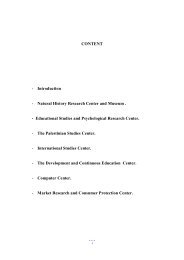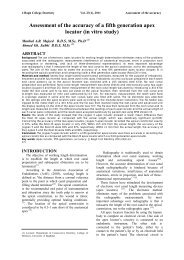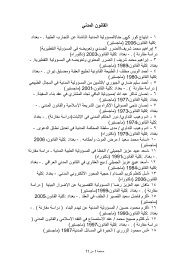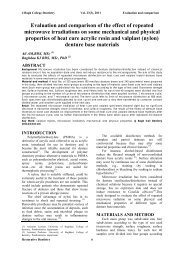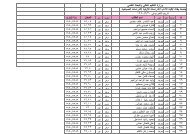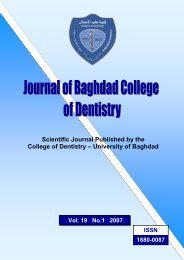Polymeric Membrane Sensors for The Selective Determination of ...
Polymeric Membrane Sensors for The Selective Determination of ...
Polymeric Membrane Sensors for The Selective Determination of ...
Create successful ePaper yourself
Turn your PDF publications into a flip-book with our unique Google optimized e-Paper software.
Iraqi J Pharm Sci, Vol.21(1) 2012<br />
<strong>Polymeric</strong> membrane sensors and pharmaceutical analysis<br />
<strong>Polymeric</strong> <strong>Membrane</strong> <strong>Sensors</strong> <strong>for</strong> the <strong>Selective</strong> <strong>Determination</strong> <strong>of</strong><br />
Metoclopramide Hydrochloride and their Applications to<br />
Pharmaceutical Analysis<br />
Abdul-Muhsin A. Al-Haideri*, Najwa I. Abdulla* ,1<br />
70<br />
and Ibtihaj K. Malih*<br />
*Chemistry Department, College <strong>of</strong> Education Ibn Al-Haitham, University <strong>of</strong> Baghdad, Baghdad, Iraq.<br />
Abstract<br />
Metoclopramide (MCP) ion selective electrodes based on metoclopramide-phosphotungstic<br />
acid (MCP-PT) ion pair complex in PVC matrix membrane were constructed. <strong>The</strong> plasticizers used<br />
were tri-butyl phosphate (TBP), di-octyl phenyl phosphonate (DOPP), di-butyl phthalate (DBPH), dioctyl<br />
phthalate (DOP), di-butyl phosphate (DBP), bis 2-ethyl hexyl phosphate (BEHP). <strong>The</strong> sensors<br />
based on TBP, DOPP, DBPH and DOP display a fast, stable and linear response with slopes 59.9, 57.7,<br />
57.4, 55.3 mV/decade respectively at pH ranged 2-6. <strong>The</strong> linear concentration range between 1.0×10 -5 –<br />
1.0×10 -2 M with detection limit 3.0×10 -6 and 4.0×10 -6 M <strong>for</strong> electrodes using TBP, DOPP and DBPH<br />
while electrode using DOP shows a linear concentration range between 3.0×10 -5 – 1.0×10 -2 M and<br />
detection limit 6×10 -6 M. <strong>The</strong> selectivity coefficient values were calculated <strong>for</strong> MCP with respect to<br />
different inorganic cations, sugars and amino acids using the MCP depending on TBP plasticizer which<br />
is also used <strong>for</strong> the determination <strong>of</strong> MCP in pure solutions and in pharmaceutical preparations by<br />
direct, standard addition methods and as an indicator electrode in potentiometric titration with<br />
phosphotungstic acid (PT) giving satisfactory results.<br />
Key words: Metoclopramide-HCl membrane sensors , Metoclopramide determination ,<br />
pharmaceutical analysis , PVC membrane sensors<br />
أقطاب غشائية بىليمرية انتقائية لتعيين ميتىكلىبرامايد هيدروكلىرايد وتطبيقاتها في<br />
التحليل الدوائي<br />
*<br />
1،<br />
عبد المحسن عبد الحميد الحيدري* ، نجىي<br />
*قسم انكُمُاء ، كهُح انرزتُح اته انهُثم ، خامعح تغذاد ، تغذاد، انعزاق.<br />
الخالصة<br />
اسحاق عبد هللا*<br />
و إبتهاج<br />
كاظم مالح<br />
ذىاوند انذراسح ذسضُز اقطاب اورقائُح غشائُح تىنُمزَح سائهح نهمُرىكهىتزاماَذ تاسرعمال انزوج االَىوٍ )MCP-PT(<br />
كمادج مرسسسح فٍ مادج كهىرَذ مرعذد انفىُم )PVC( كىسُظ نها مع انمىاد انمهذوح:<br />
Tri-butyl phosphate (TBP), di-octyl phenyl phosphonate (DOPP), di-butyl phthalate (DBPH), di-octyl<br />
phthalate (DOP), di-butyl phosphate (DBP), bis 2-ethyl hexyl phosphate (BEHP).<br />
أظهزخ دراسح خىاص ومىاصفاخ هذي األقطاب، ان األقطاب انمعرمذج عهً انمىاد انمهذوح<br />
أعطد اسرداتح سزَعح ومسرقزج وخطُح تاوسذاراخ قذرها<br />
مىالرٌ<br />
فُما ذزاوذ مذي انرزاكُز انخطُح تُه<br />
عهً انرىانٍ عىذ دانح زامضُح ذزاوزد عهً انرىانٍ تُىما أعطً<br />
مىالرٌ نألقطاب<br />
وزذ ذسسس<br />
مىالرٌ. زسثد<br />
مىالرٌ وزذ ذسسس اسرداتح خطُح نهرزكُز ذزاوزد تُه<br />
انقطة انمعرمذ عهً قُم معامم االورقائُح نقطة انمُرىكهىتزاماَذ تىخىد اَىواخ مىخثح وسكزَاخ وزىامض امُىُح مخرهفح تاسرعمال انقطة انمعرمذ عهً<br />
انمهذن .TBP ذم اخرثار انقطة انمذكىر فٍ ذعُُه ذزاكُز انمُرىكهىتزاماَذ فٍ مسانُم وقُح مسضزج مخرثزَاً ومسانُم دوائُح تاسرعمال<br />
انطزَقح انمثاشزج وطزَقح االضافاخ انقُاسُح فضال عه اسرعمال انقطة كذنُم فٍ انرسسُر انمدهادٌ ضذ مسهىل<br />
معطُاً ورائح خُذج.<br />
أقطاب غشائية للميتىكلىبرامايد هيدروكلىرايد، تقدير الميتىكلىبرامايد، التحليل الدوائي، األقطاب الغشائية<br />
الكلمات المفتاحيه الدوائية.<br />
55.3 ،<br />
55.4، 55.5 ، 55.5<br />
5-<br />
111 - 111<br />
6 – 2<br />
انمعرمذج عهً DBPH, DOPP, TBP<br />
6-<br />
2- 5-<br />
116<br />
111 - 113<br />
2-<br />
Introduction<br />
Metoclopramide hydrochloride 4-<br />
amino-5-chloro-N-[(2-diethyl amino) ethyl]-2-<br />
methoxy benzamide hydrochloride, MCP is an<br />
antiemetic procaine derivative which is<br />
currently used in gastrointestinal (GI)<br />
diagnostics. It is the active ingredient <strong>of</strong> many<br />
pharmaceutical <strong>for</strong>mulations concerned with<br />
the treatment <strong>of</strong> (GI) disorders due to the<br />
elective character <strong>of</strong> its action in various<br />
digestive manifestations in medical practice<br />
1 Corresponding author E- mail : najwa_issac@yahoo.com<br />
Received : 12/10/2011<br />
Accepted : 13/3/2012<br />
6-<br />
DOP, DBPH, DOPP, TBP<br />
mV/decade<br />
6- 6-<br />
114 ، 11 3، 113<br />
DOP<br />
phosphotungstic acid (PT)<br />
:<br />
such as, nausea, meteorism, vomiting,<br />
epigastric discom<strong>for</strong>t and to increase the<br />
gastrointestinal motility. This drug act on the<br />
muscles within the wall <strong>of</strong> the upper intestinal<br />
tract causing them to contract and to move<br />
food and fluids along. It also crosses from the<br />
blood stream into brain cells and may cause<br />
significant side effects e.g., head ache,<br />
dizziness, fatigue, dry mouth, rash. (1-3)
Iraqi J Pharm Sci, Vol.21(1) 2012<br />
<strong>Polymeric</strong> membrane sensors and pharmaceutical analysis<br />
Several analytical procedures have been<br />
reported <strong>for</strong> the quantitative determination <strong>of</strong><br />
metochlopramide in dosage <strong>for</strong>ms or in<br />
biological fluids. Among these are<br />
fluorimetric, (4) spectrophotometric, (5-8)<br />
voltammetric, (9) gas chromatography (GC), (10)<br />
high per<strong>for</strong>mance liquid chromatography<br />
(HPLC), (11,12) flameless atomic absorption<br />
spectrophotometry (13) and membrane<br />
sensors. (14,15) In recent years, the development<br />
and application <strong>of</strong> new ion selective electrodes<br />
(ISEs) have played an important role in<br />
pharmaceutical and biological analysis. (16-18)<br />
<strong>The</strong> great challenge in this field is the<br />
combination <strong>of</strong> simplicity, low cost, relatively<br />
fast response, reasonably selectivity, low<br />
detection limit, high accuracy and applicability<br />
to colored and turbid solutions. This work<br />
deals with the construction <strong>of</strong> membrane<br />
sensors that insure the determination <strong>of</strong> MCP<br />
based on the MCP ion-pair with<br />
phosphotungstic acid embedded in a PVC<br />
polymer matrix plasticized with different<br />
plasticizers. <strong>The</strong> per<strong>for</strong>mance characteristics <strong>of</strong><br />
the proposed electrodes (e.g., slope, detection<br />
limit, concentration range, response time, pH<br />
effect, and selectivity) were studied and the<br />
determination <strong>of</strong> MCP in pharmaceutical<br />
<strong>for</strong>mulations has also been investigated.<br />
Experimental Part<br />
Equipment<br />
All potentiometric measurements<br />
were carried at 25C ± 1C in a constant<br />
stirring with a Philips PW9421 (England)<br />
digital pH/mV meter using the following cell<br />
assembly: Ag, AgCl internal filling solution <br />
membrane test solution saturated calomel<br />
electrode. A Philips PW 9418 pH meter with<br />
an Orion 91-02 combined glass electrode<br />
(Switzerland) were used <strong>for</strong> pH adjustment.<br />
Reagents<br />
All chemicals used were <strong>of</strong><br />
analytical grade and were used without further<br />
purification. Metoclopramide hydrochloride<br />
was provided by the state company <strong>of</strong> drugs<br />
and medical supplies industry (SDI, Samara,<br />
Iraq), phosphotungstic acid (PT),<br />
tetrahydr<strong>of</strong>uran (THF) and PVC <strong>for</strong> ISEs by<br />
BDH, dioctyl phthalate (DOP), dibutyl<br />
phosphate (DBP), dibutyl phthalate (DBPH),<br />
dioctyl phenyl phosphonate (DOPP), tributyl<br />
phosphate (TBP) and bis 2-ethyl hexyl<br />
phosphate (BEHP) by Fluka. Pharmaceutical<br />
<strong>for</strong>mulations were obtained from the SDI, Iraq<br />
(meclodin tablets and oral pediatric drops);<br />
ZMC Hamborg GMBH, Germany (placeela<br />
injection ampoules); the Arab company <strong>for</strong><br />
drugs industry, Jordan (clopram syrup).<br />
Preparation <strong>of</strong> the ion association complex<br />
<strong>The</strong> MCP-PT ion association was<br />
prepared by mixing 40 ml <strong>of</strong> an aqueous<br />
solution <strong>of</strong> metoclopramide hydrochloride (1<br />
mmol) with 40 ml solution containing an<br />
equimolar amount <strong>of</strong> phosphotungstic acid.<br />
<strong>The</strong> resultant precipitate was filtered, washed<br />
thoroughly with double distilled water then<br />
dried at room temperature. This ion association<br />
complex was used as electro-active material in<br />
the proposed sensors.<br />
Electrode preparation<br />
Ion association complex (40 mg)<br />
was mixed with a plasticizer (360 mg) and<br />
PVC (170 mg). <strong>The</strong> mixture was dissolved in<br />
THF (7 ml). <strong>The</strong> solution was poured into a<br />
glass ring (3.5 cm in diameter) standing on a<br />
leveled glass plate, covered with a filter paper<br />
and the solvent was allowed to evaporate<br />
slowly at room temperature. (19) A transparent<br />
membrane was obtained, from which a disc <strong>of</strong><br />
about 8mm in diameter was cut out and glued<br />
to the smoothened end <strong>of</strong> a 3 cm long PVC<br />
tube by means <strong>of</strong> a PVC-THF solution. <strong>The</strong><br />
other end <strong>of</strong> the tube was connected to a glass<br />
tube which was ¾ filled with 10 -2 M solution<br />
<strong>of</strong> MCP hydrochloride as the internal reference<br />
solution in which the Ag/AgCl reference<br />
electrode was dipped. <strong>The</strong> constructed<br />
electrode was conditioned by soaking in 10 -2 M<br />
standard solution <strong>of</strong> drug <strong>for</strong> at least 2 hours<br />
be<strong>for</strong>e measurements.<br />
Electrode calibration<br />
Standard metoclopramide hydrochloride<br />
solutions (20 ml <strong>of</strong> 1.0×10 -1 - 1.0×10 -6<br />
M) were transferred into a 50 ml beaker and<br />
the sensor with the reference electrode were<br />
immersed in the solution. <strong>The</strong> measured<br />
electromotive <strong>for</strong>ce (e.m.f.) values were<br />
plotted as a function <strong>of</strong> a logarithm <strong>of</strong> the drug<br />
concentrations. <strong>The</strong> electrode was periodically<br />
recalibrated over a period <strong>of</strong> nine weeks.<br />
Selectivity <strong>of</strong> the electrode<br />
Selectivity coefficients<br />
pot<br />
K were<br />
A , B<br />
evaluated by the separate solution method (20)<br />
according to the following equation:<br />
log<br />
pot<br />
= (E B – E A )/S+(1-Z A /Z B ) log a A<br />
K<br />
A , B<br />
Where E A , E B ; Z A , Z B and a A , a B are the<br />
potentials, charge numbers and activities <strong>of</strong> the<br />
primary A and interfering B ions respectively<br />
at a A = a B .<br />
Potentiometric determination <strong>of</strong> MCP in pure<br />
samples and pharmaceutical <strong>for</strong>mulations<br />
Pure sample: aqueous solutions <strong>of</strong><br />
MCP hydrochloride equivalent to 1.0×10 -2 ,<br />
1.0×10 -3 M were prepared. Tablets: ten tablets<br />
(meclodin, 5 mg per tablet) were finely<br />
71
E(mV)<br />
Iraqi J Pharm Sci, Vol.21(1) 2012<br />
<strong>Polymeric</strong> membrane sensors and pharmaceutical analysis<br />
powdered, well mixed and an accurate weight<br />
required to prepare 10 -3 M MCP hydrochloride<br />
solution was dissolved in a minimum amount<br />
<strong>of</strong> double distilled water, filtered into a 25 ml<br />
volumetric flask and diluted to the mark.<br />
Injection ampoules (placeela), oral pediatric<br />
drops (meclodin) and syrup (clopram): an<br />
accurate volumes (12 ml, 7.5 ml, 30 ml) <strong>of</strong><br />
each <strong>for</strong>mulation respectively were<br />
quantitatively and separately transferred into<br />
100 ml volumetric flasks and the volumes were<br />
completed to the mark with double distilled<br />
water to get solutions <strong>of</strong> 10 -3 M MCP<br />
hydrochloride. As pure and pharmaceutical<br />
samples: a 20 ml aliquot <strong>of</strong> the drug solution<br />
was potentiometrically measured as described<br />
and the potential reading was compared with<br />
the calibration plot. Alternatively the standard<br />
addition method was applied by measuring the<br />
potentials <strong>of</strong> the drug test solution be<strong>for</strong>e and<br />
after the addition <strong>of</strong> small increments (0.2 ml)<br />
<strong>of</strong> a standard solution (10 -1 M) <strong>of</strong> MCP<br />
hydrochloride. <strong>The</strong> change in the electrode<br />
potential (E) at constant temperature <strong>of</strong> 25C<br />
was recorded and used to calculate the<br />
concentration <strong>of</strong> the drug. (21) A potentiometric<br />
titration was also applied when 10 mL aliquot<br />
<strong>of</strong> the drug test solution were diluted to 100 ml<br />
with double distilled water. <strong>The</strong> resultant<br />
solution was titrated with (10 -2 and 10 -3 M)<br />
standard solution <strong>of</strong> PT using MCP membrane<br />
electrode as the sensor.<br />
Results and Discussion<br />
<strong>Membrane</strong> composition and electrode<br />
response<br />
metoclopramide hydrochloride<br />
phosphotungstate is a stable water insoluble<br />
ion pair complex but readily soluble in organic<br />
solvents such as tetrahydr<strong>of</strong>uran. <strong>The</strong> complex<br />
was dispersed in a PVC membrane as an active<br />
material with the following plasticizers:<br />
tributyl phosphate (TBP), dioctyl phenyl<br />
phosphonate (DOPP), dibutyl phthalate<br />
(DBPH), dioctyl phthalate (DOP), dibutyl<br />
phosphate (DBP) and bis(2-ethyl-hexyl<br />
phosphate) (BEHP). <strong>The</strong> per<strong>for</strong>mance<br />
characteristics <strong>of</strong> the proposed sensors based<br />
on data collected over a period <strong>of</strong> nine weeks<br />
were evaluated according to IUAPC<br />
recommendations. (22) <strong>The</strong> results were<br />
summarized in Table 1. A typical calibration<br />
graph <strong>of</strong> MCP sensors is shown in Figure1. It<br />
is well known that the nature <strong>of</strong> the plasticizer<br />
significantly influence the sensitivity, linearity<br />
and life time <strong>of</strong> the polymeric membrane<br />
sensors. <strong>The</strong> plasticizers insured the mobility<br />
<strong>of</strong> the membrane constituents within the<br />
membrane phase by lowering the viscosity <strong>of</strong><br />
the polymer matrix, set the dielectric constant<br />
<strong>of</strong> the membrane phase and provide a suitable<br />
mechanical properties <strong>of</strong> the membrane. (23,24)<br />
Non- Nernstian slopes were obtained with<br />
sensors depending on DBP and BEHP. <strong>The</strong>ir<br />
slopes were (40.7 and 29.0) mV/decade with<br />
correlation coefficients <strong>of</strong> 0.9982 and 0.9979<br />
respectively. <strong>The</strong> linear range <strong>of</strong> concentration<br />
were 1.0×10 -4 - 1.0×10 -2 M and 6.0×10 -4 -<br />
5.0×10 -2 M with detection limits 4.0×10 -5 M<br />
and 2.0×10 -4 M respectively. <strong>The</strong> poor results<br />
<strong>for</strong> sensors using DBP and BEHP can be<br />
attributed to the low solubility or low<br />
distribution <strong>of</strong> MCP-PT ion pair in these<br />
plasticizers that have high viscosity (112.89<br />
and 272.54) cST. On the other hand the<br />
membranes based on DOPP, DBPH and DOP<br />
gave a near Nernstian slopes <strong>of</strong> (57.7, 57.4 and<br />
55.3) mV/decade with correlation coefficients<br />
<strong>of</strong> 0.9996, 0.9996 and 0.9986 respectively. <strong>The</strong><br />
linear range <strong>of</strong> these membranes were 1.0×10 -5<br />
- 1.0×10 -2 M <strong>for</strong> membranes using DOPP and<br />
DBPH, and 3.0×10 -5 - 1.0×10 -2 M <strong>for</strong> DOP<br />
with detection limits <strong>of</strong> 4.0×10 -6 M, 4.0×10 -6 M<br />
and 6.0×10 -6 M respectively. A Nernstian slope<br />
<strong>of</strong> 59.9 mV/decade with correlation coefficient<br />
<strong>of</strong> 0.9998 was obtained <strong>for</strong> membrane based<br />
on TBP and a linear concentration range<br />
1.0×10 -5 - 1.0×10 -2 M and detection limit<br />
3.0×10 -6 M. <strong>The</strong> stability <strong>of</strong> electrodes was<br />
monitored continuously by measuring the<br />
potential drift and evaluate it <strong>for</strong> a period <strong>of</strong> 15<br />
days. <strong>The</strong> standard deviations <strong>of</strong> the potential<br />
drift obtained <strong>for</strong> these 15 days were ± 1, ± 1,<br />
± 1, ± 4, ± 9 and ± 12 mV <strong>for</strong> membranes No.<br />
I, II, III, IV, V and VI respectively.<br />
250<br />
200<br />
150<br />
100<br />
50<br />
0<br />
-5 0<br />
TBP<br />
DOPP<br />
DBPH<br />
DOP<br />
-1 00<br />
1.0E-7 1.0E-6 1.0E-5 1.0E-4 1.0E-3 1.0E-2 1.0E-1 1.0E+0<br />
concentration <strong>of</strong> MCP (M)<br />
Figure 1: Calibration curves <strong>of</strong><br />
metoclopramide hydrochloride electrode<br />
72
Iraqi J Pharm Sci, Vol.21(1) 2012<br />
<strong>Polymeric</strong> membrane sensors and pharmaceutical analysis<br />
Table 1: Parameters <strong>of</strong> metoclopramide hydrochloride selective electrodes<br />
Parameters<br />
Electrode number<br />
I II III IV V VI<br />
plasticizer TBP DOPP DBPH DOP DBP BEHP<br />
Slope mV/decade 59.9 57.7 57.4 55.3 40.7 29.0<br />
Correlation coefficient 0.9998 0.9996 0.9996 0.9986 0.9982 0.9979<br />
Linear range (M)<br />
1.0×10 -5 – 1.0×10 -5 – 1.0×10 -5 – 3.0×10 -5 – 1.0×10 -4 – 6.0×10 -4 –<br />
1.0×10 -2 1.0×10 -2 1.0×10 -2 1.0×10 -2 1.0×10 -2 5.0×10 -2<br />
Detection limit (M) 3.0×10 -6 4.0×10 -6 4.0×10 -6 6.0×10 -6 4.0×10 -5 2.0×10 -4<br />
Response time<br />
1.0×10 -1 – 1.0×10 -5<br />
5 – 9 5 – 15 5 – 15 7 – 12 30 – 39 60 – 75<br />
Life time (day) 52 52 50 64 28 4<br />
Potential drift (mV/day) 1 1 1 4 9 12<br />
Soaking effect<br />
<strong>Membrane</strong>s that are freshly prepared<br />
must be soaked in their standard solutions<br />
be<strong>for</strong>e using to <strong>for</strong>m a thin surface gel layer <strong>for</strong><br />
ion exchange process to occur. (25) Soaking<br />
require different times depending on the<br />
diffusion and equilibration at the electrode-test<br />
solution interface. A fast equilibrium<br />
establishment is a condition <strong>of</strong> a fast potential<br />
response. (26) It was observed that continuous<br />
soaking <strong>of</strong> the MCP electrodes in 1.0×10 -2 M<br />
solution <strong>of</strong> MCP hydrochloride at room<br />
temperature negatively affects their response to<br />
MCP due to leaching out <strong>of</strong> the membrane<br />
components to the external solution. <strong>The</strong><br />
optimal conditioning time <strong>for</strong> the proposed<br />
MCP membranes was found to be about 2-3<br />
hours.<br />
Life time<br />
<strong>The</strong> life time <strong>of</strong> the sensors was<br />
studied by recalibrating the sensors<br />
periodically (every three days) over a period <strong>of</strong><br />
nine weeks. <strong>The</strong> electrode depending on DOP<br />
was used successfully <strong>for</strong> 64 days and the<br />
electrodes depending on DOPP, TBP and<br />
DBPH were used <strong>for</strong> 52 and 50 days without<br />
significant changes in the electrode<br />
parameters. However, the life times <strong>of</strong> the<br />
electrodes depending on DBP and BEHP were<br />
28 and 4 days due to leaching out <strong>of</strong> the<br />
membrane incompatible components.<br />
Response time<br />
<strong>The</strong> response time <strong>of</strong> an electrode is<br />
evaluated by measuring the average time<br />
required to achieve a potential within ±1 mV<br />
<strong>of</strong> the final steady state potential, upon<br />
successive immersion <strong>of</strong> a series <strong>of</strong> interested<br />
ions, each having a ten-folds difference in<br />
concentration. It is notable that the<br />
experimental conditions like the stirring or<br />
flow rate, the ionic concentration and<br />
composition <strong>of</strong> the test solution, any previous<br />
usage or preconditioning <strong>of</strong> the electrode, and<br />
the testing temperature have an ef<strong>for</strong>t on the<br />
experimental response time <strong>of</strong> a sensor. (27) <strong>The</strong><br />
response times <strong>for</strong> the MCP proposed<br />
electrodes at different concentrations <strong>of</strong> MCP<br />
solutions ranging from 1.0×10 -5 to 1.0×10 -1 M<br />
were calculated and listed in Table 1. A plot <strong>of</strong><br />
the electrode response with time <strong>for</strong> electrode<br />
no.I is shown in Figure 2. <strong>The</strong> response time<br />
<strong>for</strong> all electrodes ranged (5-7) sec. <strong>for</strong> 1.0×10 -1<br />
M solutions and (9-15) sec. <strong>for</strong> 1.0×10 -5 M<br />
solutions except the electrodes depending on<br />
DBP and BEHP, where they showed longer<br />
response time (39 – 30) sec. and (75 – 60) sec.<br />
<strong>for</strong> 10 -5 – 10 -1 M respectively which could be<br />
attributed to the high viscosity <strong>of</strong> the<br />
plasticizers used which slow down the<br />
mobility <strong>of</strong> the ion pair within the membrane<br />
and cause the equilibrium process to take<br />
longer time.<br />
Figure 2. <strong>The</strong> response time <strong>of</strong> TBP<br />
electrode using 10 -5 M metoclopramide<br />
hydrochloride<br />
pH-effect<br />
<strong>The</strong> influence <strong>of</strong> the pH on the<br />
response <strong>of</strong> MCP membrane sensors was<br />
checked using 10 -2 M and 10 -3 M MCP<br />
hydrochloride solutions and recording the<br />
e.m.f. at different pH values. <strong>The</strong> pH was<br />
adjusted by the addition <strong>of</strong> very small volumes<br />
<strong>of</strong> 0.1 M hydrochloric acid or sodium<br />
hydroxide solutions. As can be seen in Figure<br />
3, the electrode potential is practically<br />
73
Iraqi J Pharm Sci, Vol.21(1) 2012<br />
<strong>Polymeric</strong> membrane sensors and pharmaceutical analysis<br />
independent <strong>of</strong> the pH range 2.0 – 6.0 <strong>for</strong><br />
membrane depending on TBP. <strong>The</strong><br />
considerable decrease <strong>of</strong> the potential observed<br />
at pH values higher than 6.0 is due to the MCP<br />
base was precipitated and this leads to the<br />
decrease in the concentration <strong>of</strong> the protonated<br />
species and lowers e.m.f. readings. This can be<br />
viewed from the consideration that the<br />
dissociation constant <strong>of</strong> MCP hydrochloride,<br />
pKa is 9 so, at pH values higher than 6<br />
(decrease in the concentration <strong>of</strong> H + ) the<br />
dissociation <strong>of</strong> MCP hydrochloride will<br />
increase and more precipitate will <strong>for</strong>m in the<br />
presence <strong>of</strong> sodium ions which leads to a<br />
decrease in the concentration <strong>of</strong> the protonated<br />
species. At pH below 2.0 a sharp increase <strong>of</strong><br />
the e.m.f. was noticed indicating that the<br />
membrane sensor responds to hydrogen<br />
ions (14) .<br />
Figure 3:pH effect on electrode response<br />
using electrode based on TBP, 0.001M,<br />
0.01M metoclopramide hydrochloride<br />
Table 2 illustrates the working pH range <strong>for</strong> all<br />
the constructed MCP-PT the membrane<br />
sensors.<strong>The</strong> MCP electrode depending on TBP<br />
was selected <strong>for</strong> carrying out the remaining<br />
studies. It showed a good, fast and stable<br />
response over a period <strong>of</strong> 52 days with a wide<br />
linear range and low detection limit.<br />
Table 2: Working pH range <strong>for</strong><br />
metoclopramide electrodes<br />
Electrode Plasticizer pH range<br />
No.<br />
I TBP 2.0 – 6.0<br />
II DOPP 3.9 – 6.4<br />
III DBPH 3.0 – 6.0<br />
IV DOP 3.2 – 5.5<br />
V DBP 6.0 – 9.2<br />
VI BEHP 5.0 – 8.0<br />
Selectivity measurements<br />
One <strong>of</strong> the important characteristic<br />
<strong>of</strong> any selective sensor is its response to the<br />
primary ion (MCP) in the presence <strong>of</strong> other<br />
ions (J) present in solutions which is expressed<br />
in term <strong>of</strong> the potentiometric selectivity<br />
coefficient pot<br />
K . It is well known that the<br />
MCP<br />
, J Z<br />
<br />
selectivity <strong>of</strong> ion-pair association based<br />
membrane sensors depends on the selectivity<br />
<strong>of</strong> the ion exchange process at the membranetest<br />
solution interface, the mobility <strong>of</strong> the<br />
respective ions within the membrane and the<br />
hydrophobic interactions between the primary<br />
ion and the membrane. <strong>The</strong> influence <strong>of</strong> some<br />
inorganic cations, sugars and amino acids on<br />
the MCP electrode was determined by the<br />
separate solution method. Figure 4 illustrates a<br />
typical plot <strong>for</strong> the selectivity <strong>of</strong> MCP<br />
electrode to lactose. As can be seen from Table<br />
3, none <strong>of</strong> the investigated species was found<br />
to interfere as shown by the very small values<br />
<strong>of</strong> pot<br />
K which means that the MCP-PT ion<br />
MCP<br />
, J Z<br />
<br />
pair used in the sensor was completely<br />
dissociated in the organic phase <strong>of</strong> the<br />
membrane and reflects the high selectivity <strong>of</strong><br />
the MCP-PT electrode towards MCP. <strong>The</strong><br />
inorganic cations do not interfere owing to the<br />
differences in ionic size and consequently their<br />
mobility and permeability as compared with<br />
those <strong>of</strong> MCP + . <strong>The</strong> selectivity in the case <strong>of</strong><br />
sugars and amino acids is attributed to the<br />
differences in the polarity and lipophilic nature<br />
<strong>of</strong> these molecules relative to MCP.<br />
Table 3: Selectivity coefficient values <strong>of</strong> various interfering compound <strong>for</strong> metoclopramide<br />
electrode I<br />
Concentrations <strong>of</strong> metoclopramide hydrochloride<br />
Interfering ion 10 -1 M 10 -2 M 10 -3 M 10 -4 M 10 -5 M 10 -6 M<br />
K A,B K A,B K A,B K A,B K A,B K A,B<br />
K + 4.0×10 -1 4.2×10 -1 2.6×10 -4 4.3×10 -3 1.6×10 -2 6.0×10 -2<br />
+<br />
NH 4 7.7×10 -3 7.7×10 -3 8.0×10 -2 7.9×10 -1 1.9×10 -1 1.6×10 -1<br />
Cu 2+ 6.3×10 -5 5.8×10 -5 2.0×10 -4 5.4×10 -4 1.9×10 -3 1.2×10 -2<br />
glucose 2.8×10 -4 9.3×10 -4 8.9×10 -3 8.9×10 -2 6.4×10 -1 6.3×10 -1<br />
lactose 2.4×10 -4 6.7×10 -4 6.3×10 -3 5.8×10 -2 5.8×10 -1 8.7×10 -1<br />
sucrose 1.2×10 -4 6.0×10 -4 3.7×10 -3 6.6×10 -2 3.6×10 -1 1.1×10 -2<br />
Alanin 1.5×10 -3 4.3×10 -3 5.4×10 -2 5.1×10 -1 1.7×10 -1 1.5×10 -1<br />
Glycine 2.3×10 -3 4.5×10 -3 8.0×10 -3 3.6×10 -1 2.1×10 -1 1.3×10 -1<br />
74
Iraqi J Pharm Sci, Vol.21(1) 2012<br />
<strong>Polymeric</strong> membrane sensors and pharmaceutical analysis<br />
Figure 4: Selectivity <strong>of</strong> electrode using TBP<br />
to lactose interfering by seperate solution<br />
method<br />
Analytical application<br />
<strong>The</strong> usefulness <strong>of</strong> metoclopramide<br />
electrodes in the determination <strong>of</strong> MCP<br />
hydrochloride in pure solutions 10 -2 , 10 -3 M<br />
and in some pharmaceutical preparations was<br />
examined by direct, standard addition, multiple<br />
standard addition and potentiometric titration.<br />
<strong>The</strong> statistical analysis <strong>of</strong> the analytical results<br />
illustrated in Table 4 encouraged us to use the<br />
proposed electrode <strong>for</strong> the determination <strong>of</strong><br />
MCP hydrochloride in some pharmaceutical<br />
preparations (tablets, ampoules, drops and<br />
syrup) the results are listed in Table 5<br />
presented by recovery %R, relative standard<br />
deviation %RSD and relative error %RE. the<br />
relative recovery was calculated <strong>for</strong> 5 additions<br />
<strong>of</strong> 0.1 M MCP hydrochloride solutions.<br />
Table 4: Metoclopramide hydrochloride pure samples analysis by potentiometric techniques<br />
using electrode I*<br />
Sample (M)<br />
Measurements by potentiometric methods<br />
Direct S.A. M.S.A. Titration<br />
1×10 -2 1.001×10 -2 1.005×10 -2 0.992×10 -2 0.995×10 -2<br />
%RSD 1.409 1.404 0.565 0.353<br />
%RC 100.1 100.5 99.2 99.5<br />
%RE 0.1 0.5 -0.8 -0.5<br />
1×10 -3 1.002×10 -3 1. 003×10 -3 0.991×10 -3 0.993×10 -3<br />
%RSD 1.408 1.407 0.635 0.504<br />
%RC 100.2 100.3 99.1 99.3<br />
%RE 0.2 0.2 -0.9 -0.7<br />
*Each value represents an average <strong>of</strong> 3 measurements.<br />
Table 5: <strong>Determination</strong> <strong>of</strong> metoclopramide hydrochloride in some pharmaceutical <strong>for</strong>mulations<br />
by potentiometric methods using electrode I*<br />
Pharmaceutical<br />
<strong>for</strong>mulation<br />
Sample (M) Direct S.A. M.S.A.<br />
1.000 10 -3 1.002×10 -3 1. 018×10 -3 1. 003×10 -3<br />
Tablets<br />
%RSD 1.411 1.386 1.407<br />
%RC 100.2 101.8 100.3<br />
%RE 0.1 1.8 0.3<br />
1.000 10 -3 0.997×10 -3 0.995×10 -3 1. 001×10 -3<br />
Injection ampoules<br />
%RSD 1.418 2.125 1.400<br />
%RC 99.7 99.5 100.1<br />
%RE -0.3 -0.5 +0.1<br />
1.000 10 -3 0.992×10 -3 0.991×10 -3 1. 002×10 -3<br />
Oral pediatric drops<br />
%RSD 1.420 0.630 1.272<br />
%RC 99.2 99.1 100.2<br />
%RE -0.8 -0.9 0.2<br />
1.000 10 -3 1. 003×10 -3 1. 001×10 -3 0.990×10 -3<br />
Syrup<br />
%RSD 2.100 0.700 1.331<br />
%RC 100.3 100.1 99.0<br />
%RE 0.3 0.1 -1.0<br />
*Each value represents an average <strong>of</strong> 3 measurements.<br />
75
Iraqi J Pharm Sci, Vol.21(1) 2012<br />
<strong>Polymeric</strong> membrane sensors and pharmaceutical analysis<br />
A typical plot <strong>of</strong> antilog E/S versus the volume<br />
<strong>of</strong> the standard MCP together with the<br />
concentration <strong>of</strong> pure 10 -3 M <strong>of</strong> MCP is shown<br />
in Figure 5. Gran’s plot paper with 10%<br />
volume correction was used. For<br />
potentiometric titration <strong>of</strong> MCP hydrochloride,<br />
a typical titration plot <strong>of</strong> 10 -3 M MCP with 10 -<br />
3 M PT is shown in Figure 6. <strong>The</strong> values <strong>of</strong><br />
standard deviation and recovery given in Table<br />
4 and 5 prove that the electrode depending on<br />
TBP plasticizers is very successful <strong>for</strong> the<br />
determination <strong>of</strong> MCP either in pure or<br />
pharmaceutical <strong>for</strong>mulations. <strong>The</strong> good<br />
agreement between data obtained by the<br />
proposed sensor and the standard pharmacopial<br />
method (28) and the spectrophotometric<br />
method (8) confirming the applicability <strong>of</strong> the<br />
sensor <strong>for</strong> the analysis <strong>of</strong> controlled drugs.<br />
Figure 5: Plot <strong>of</strong> antilog (E/S) vs. the volume<br />
<strong>of</strong> 0.1M standard metoclopramide by MSA<br />
using TBP electrode<br />
Figure 6: Titration curve <strong>of</strong> 10 -3 M<br />
metoclopramide titrated with 10 -3 M<br />
phosphotungstic acid using TBP electrode<br />
Conclusion<br />
MCP selective electrodes based on<br />
ion pair complex <strong>of</strong> MCP-PT incorporating<br />
different plasticizers were constructed. <strong>The</strong><br />
best MCP electrode was based on TBP. It gave<br />
excellent electrode parameters and no<br />
interference with several cations, sugars and<br />
amino acids. This electrode was used <strong>for</strong> the<br />
drug determination in pharmaceutical<br />
preparations and <strong>of</strong>fers a simple, rapid and cost<br />
effective with high precision and accuracy<br />
method.<br />
References<br />
1. Martindale <strong>The</strong> Complete Drug<br />
Reference, 32 nd edition, Sweetman S.C.,<br />
Pharmaceutical Press, London, 1999.<br />
2. Bennett, P.N.; Brown, M.J. Clinical Ph.,<br />
10 th edition, Churchill Livingstone,<br />
University <strong>of</strong> Cambridge, England, 2008.<br />
3. Golan, D.E.; Tashijian, A.H.; Armstrong,<br />
E.J. Principle <strong>of</strong> Pharmacology, 2 nd<br />
edition, Lippincott Williams & Wilkins,<br />
Baltimore MD, USA, 2008.<br />
4. Buna, M.; Aaron, J.J.; Prognon, P.;<br />
Mahuzier, G. Effects <strong>of</strong> pH and solvent<br />
on the fluorescence properties <strong>of</strong><br />
biomedically important benzamides.<br />
Application to determination in drugs and<br />
in human urine, Analyst 1996, 121, 1551<br />
– 1556.<br />
5. Revanasiddappa, H.D.; Manju, B.<br />
Evaluation <strong>of</strong> metoclopramide syrups by<br />
Bratton-Marshall method, J.Pharm.<br />
Biomed. Anal. 2001; 25: 631 – 637.<br />
6. Moussa, B.A. <strong>Determination</strong> <strong>of</strong> some<br />
amino benzoic acid derivatives glafinine<br />
and metoclopramide, J. Pharm. Biomed.<br />
Anal. 2000; 23: 1045 – 1055.<br />
7. Abdel-Gawad, F.M.; El-Guindi, N.M.<br />
Spectrophotometric determination <strong>of</strong><br />
metoclopramide and oxybuprocaine<br />
through ion-pair <strong>for</strong>mation with<br />
thiocyanate and molybdenum (V) or<br />
cobalt (II) Anal. Lett. 1995;28: 1437 –<br />
1447.<br />
8. Dudhane, N.P.; Vidhate, S.S.; Borkar,<br />
B.H.; Lohiya, R.T.; Umekar, M.J.<br />
Simultaneous U.V. spectrophotometric<br />
estimation <strong>of</strong> metoclopramide<br />
hydrochloride and paracetamol in solid<br />
dosage <strong>for</strong>m, J. Pharm. Sci. and Res.<br />
2010;2(1): 48 – 52.<br />
9. Wang Z.H.; Zhang, H.Z.; Zhou, S.P.;<br />
Dong, W.J. <strong>Determination</strong> <strong>of</strong> trace<br />
metoclopramide by anodic stripping<br />
voltammetry with nafion modified glassy<br />
carbon electrode, Talanta 2001; 53:1133<br />
– 1138.<br />
10. Ross-Lee, L.M.; Eadie, M.J.; Bochner,<br />
F.; Hooper, W.D.; Tyrer, J.H. Electroncapture<br />
gas chromatographic assay <strong>for</strong><br />
metoclopramide in plasma, J.<br />
Chromatogr. Biomed. Appl. 1980;9: 175<br />
– 184.<br />
11. Radwan, M.A. <strong>Determination</strong> <strong>of</strong><br />
metoclopramide in serum by HPLC assay<br />
76
Iraqi J Pharm Sci, Vol.21(1) 2012<br />
<strong>Polymeric</strong> membrane sensors and pharmaceutical analysis<br />
and its application to pharmacokinetic<br />
study in rat Anal. Lett. 1998; 31: 2397 –<br />
2410.<br />
12. Venkateshwaran, T.G.; King, D.T.;<br />
Stewart, J.T. HPLC determination <strong>of</strong> a<br />
metoclopramide and ondansetron mixture<br />
in 0.9% sodium chloride injection, J. Liq.<br />
Chromatogr. 1995;18: 117 – 126.<br />
13. Park, M.K.; Lim, B.R.; Yu, K.S.; Yong,<br />
K.H.; Hoe, Y. Chi. 1978; 22:27 – 43.<br />
14. Elazazy, M.S.; Shalaby, A.; Elbolkiny,<br />
M.N.; Khalil, H.M. Per<strong>for</strong>mance and<br />
characteristics <strong>of</strong> new metoclopramide<br />
selective membrane electrode, <strong>The</strong><br />
Chinese Pharmaceutical Journal<br />
2004;56(1):49 – 56.<br />
15. Faridbod, F.; Ganjali, M.R.; Labbafi, S.;<br />
Dinarvand, R.; Riahi, S.; Norouzi, P. A<br />
new metoclopramide potentiometric<br />
membrane sensor analysis in<br />
pharmaceutical <strong>for</strong>mulation and urine,<br />
Int. J. Electrochem. Sci. 2009; 4:772 –<br />
786.<br />
16. Ganjali, M.R.; Hariri, M.; Riahi, S.;<br />
Norouzi, P.; Javaheri, M.<br />
Phenylprpanolamine analysis in<br />
<strong>for</strong>mulation and urine by potentiometric<br />
membrane sensor, Int. J .Electrochem.<br />
Sci. 2009; 4: 295 – 307.<br />
17. Ganjali, M.R.; Razavi, T.; Dinarvand, R.;<br />
Riahi, S.; Norouzi, P. New diltiazem<br />
potentiometric membrane sensor stands<br />
on theoretical calculations as a useful<br />
device <strong>for</strong> diltiazem hydrochloride<br />
analysis in pharmaceutical <strong>for</strong>mulation<br />
and urine, Int. J .Electrochem. Sci. 2008;<br />
3: 1543 – 1558.<br />
18. Hassan, A.K.; Ameen, S.T.; Saad, B.; Al-<br />
Araji, S.M. Potentiometric sensors <strong>for</strong> the<br />
determination <strong>of</strong> trifluoperazine<br />
hydrochloride in pharmaceutical<br />
preparations, Analytical Sciences<br />
2009;25: 1295 – 1299.<br />
19. Craggs, A.; Moody, G.J.; Thomas, J.D.R.<br />
PVC matrix membrane ion-selective<br />
electrodes. Construction and laboratory<br />
experiments, J. Chem. Edu. 1974;51: 541<br />
– 544.<br />
20. Umezawa, Y.; Buhlman, P.; Umezawa,<br />
K.; Tohda, K.; Amemiya, S.<br />
Potentiometric selectivity coefficients <strong>of</strong><br />
ion-selective electrodes part 1 inorganic<br />
cations, Pure Appl. Chem. 2000; 72:1851<br />
– 2082.<br />
21. Evans, A. Potentiometry and Ion<br />
<strong>Selective</strong> Electrodes, John Wiley and<br />
Sons Inc., New York, 1987.<br />
22. IUPAC Analytical Chemistry Division,<br />
Commision on Analytical Nomenclature<br />
Selectivity coefficient <strong>for</strong> ion-selective<br />
electrodes: recommended methods <strong>for</strong><br />
reporting K pot values, Pure Appl. Chem.<br />
1995; 67: 507 – 518.<br />
23. Faridbod, F.; Ganjali, M.R.; Dinarvand<br />
R.; Norouzi, P. <strong>The</strong> fabrication <strong>of</strong><br />
potentiometric membrane sensors and<br />
their applications, Afri. J. Biotech.<br />
2007;6: 2960 – 2987.<br />
24. Lindner, E.; Umezawa, Y. Per<strong>for</strong>mance<br />
evaluation criteria <strong>for</strong> preparation and<br />
measurement <strong>of</strong> macro- and micr<strong>of</strong>abricated<br />
ion selective electrodes, Pure<br />
Appl. Chem. 2008; 80: 85 – 104.<br />
25. Issa, Y.M.; Hassouna, M.M.; Abdel-<br />
Gawad, F.M.; Hussien, E.M. Poly (vinyl<br />
chloride) ion-selective electrodes <strong>for</strong><br />
peribedil determination, J.Pharm.<br />
Biomed. Anal. 2000; 23: 493 – 502.<br />
26. Lindner, E.; Toth, K.; Pungor, E.<br />
Dynamic Characteristics <strong>of</strong> Ion <strong>Selective</strong><br />
Electrodes, CRC Press, Boca Raton 1988.<br />
27. Faridbod, F.; Ganjali, M.R.; Dinarvand,<br />
R.; Norouzi, P.; Riahi, S. Schiff bases and<br />
crown ethers as supra-molecular sensing<br />
materials in the construction <strong>of</strong><br />
potentiometric membrane sensors,<br />
<strong>Sensors</strong> 2008;8: 1645 – 1703.<br />
28. British Pharmacopoeia on CD-ROM,<br />
Version 4, Copyright by Crown Ltd.,<br />
London, 94, 2000.<br />
77



